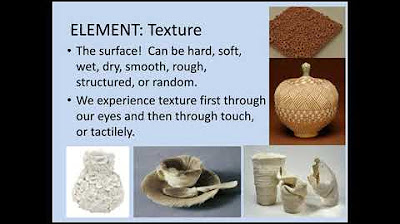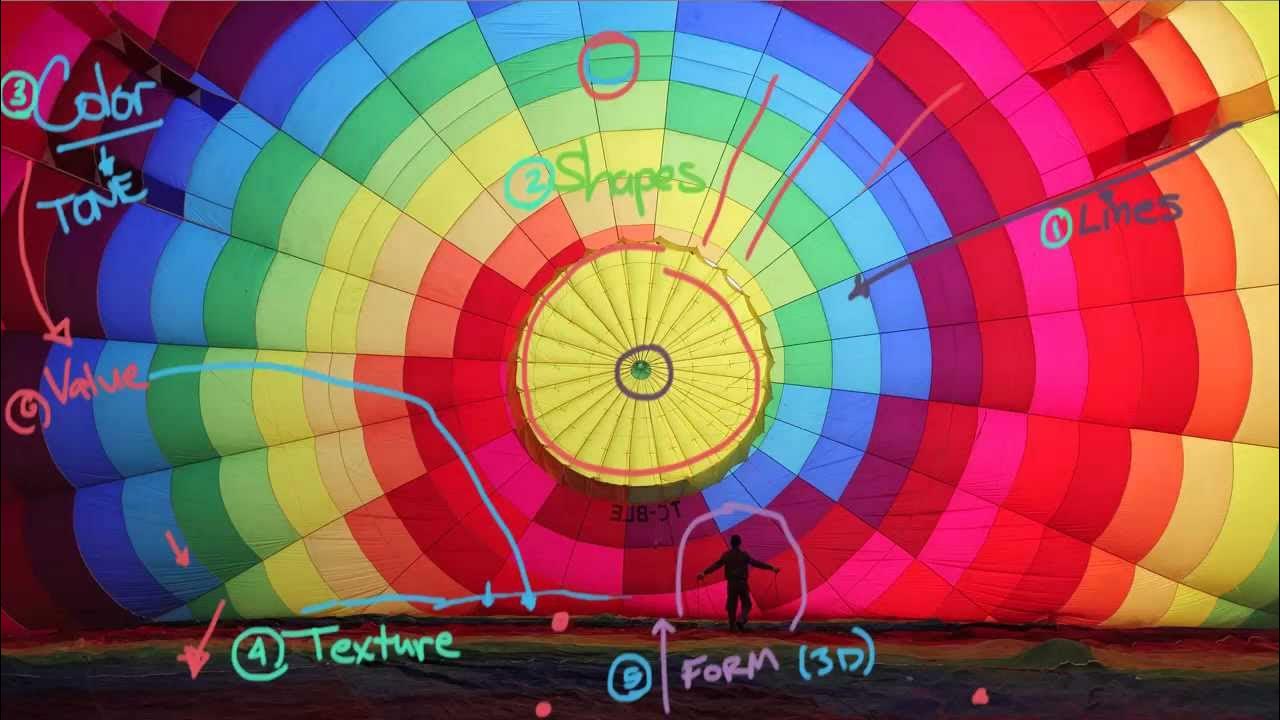Lecture: Formal Elements and Principles of Design
Summary
TLDRThis presentation delves into the concept of 'form' in art, highlighting its structure composed of formal elements and principles of design. It distinguishes between content and form, emphasizing the latter's role in engaging viewers. The discussion covers various formal elements such as line, color, texture, space, and perspective, each with its unique characteristics and examples. It also explores principles of design like balance, emphasis, proportion, repetition, rhythm, unity, and variety, illustrating how they contribute to the composition and visual appeal of artworks.
Takeaways
- 🎨 Form in art encompasses both formal elements and principles of design, which together create the overall structure of an artwork.
- 👀 Lines can be actual or implied, and they come in various types such as outline, contour, implied, and expressive lines, each serving a different purpose in art.
- 🌈 Color is a formal element with primary, secondary, and tertiary types, and it can be manipulated to create different moods and effects in a piece.
- 🖼️ Texture can be actual, where you can feel the physical bumps and grooves, or implied, where the artwork suggests a texture through visual cues.
- 📏 Perspective and space are crucial for creating depth and the illusion of three dimensions on a two-dimensional surface.
- 🔵 The use of color schemes like monochromatic, polychromatic, analogous, and complementary can greatly influence the mood and visual appeal of an artwork.
- 🌐 Negative and positive space work together to create balance and focus in an artwork, with negative space often being just as important as the subject itself.
- 🎭 Principles of design such as balance, emphasis, proportion, repetition, rhythm, unity, and variety guide how artists arrange elements within a composition.
- 👁️🗨️ Emphasizing certain elements through techniques like chiaroscuro (the use of light and dark) can draw the viewer's eye and create focal points in art.
- 🔶 Shape and form are distinct; shapes are two-dimensional, while forms have three-dimensional qualities, adding depth to artwork.
- 🖌️ Techniques like hatching, cross-hatching, and chiaroscuro are used to create the illusion of depth, volume, and light in two-dimensional art.
Q & A
What is the main focus of the presentation?
-The presentation focuses on introducing the concept of form in art and preparing viewers to conduct a formal analysis of artworks.
What are the two aspects that form is comprised of?
-Form is comprised of formal elements and principles of design.
What is the difference between content and form in art as discussed in the interview with Jacob Lawrence?
-Jacob Lawrence discusses that form is important to engage the viewer initially, which then leads to their interest in the content of the artwork.
What are the five formal elements that contribute to a work's form?
-The five formal elements are line, color, texture, space, and perspective.
What are the four types of lines in art?
-The four types of lines are outline, contour, implied, and expressive lines.
Can you explain the difference between primary, secondary, and intermediate colors?
-Primary colors are red, yellow, and blue. Secondary colors result from mixing two primary colors. Intermediate or tertiary colors result from mixing one primary and one secondary color.
What is the term used to describe the strength or brightness of a color?
-Intensity is the term used to describe the strength or brightness of a color.
What is the difference between tint and shade in color theory?
-A tint is created by adding white to a color, while a shade is created by adding black to a color.
What are the two types of color schemes that use a single color?
-Monochromatic and analogous color schemes use a single color and its variations.
How does atmospheric perspective contribute to the illusion of depth in a painting?
-Atmospheric perspective contributes to the illusion of depth by making distant objects appear hazy, less distinct, and cooler in color.
What is the difference between shape and form in art?
-Shape refers to flat, two-dimensional areas, while form refers to solid, three-dimensional spaces with mass and volume.
What are the three types of balance in art?
-The three types of balance in art are symmetrical, asymmetrical, and radial balance.
How does the principle of emphasis guide the viewer's eye in a composition?
-Emphasis is used to draw the viewer's eye to a particular aspect of a composition, often through techniques like color schemes or chiaroscuro.
Outlines

Esta sección está disponible solo para usuarios con suscripción. Por favor, mejora tu plan para acceder a esta parte.
Mejorar ahoraMindmap

Esta sección está disponible solo para usuarios con suscripción. Por favor, mejora tu plan para acceder a esta parte.
Mejorar ahoraKeywords

Esta sección está disponible solo para usuarios con suscripción. Por favor, mejora tu plan para acceder a esta parte.
Mejorar ahoraHighlights

Esta sección está disponible solo para usuarios con suscripción. Por favor, mejora tu plan para acceder a esta parte.
Mejorar ahoraTranscripts

Esta sección está disponible solo para usuarios con suscripción. Por favor, mejora tu plan para acceder a esta parte.
Mejorar ahora5.0 / 5 (0 votes)






